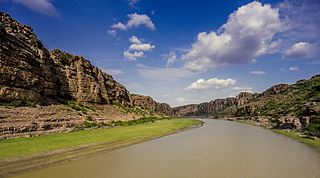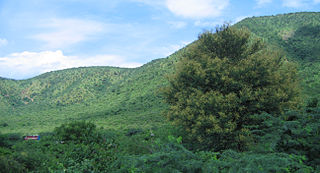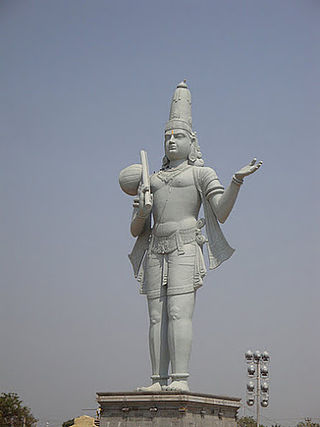Cheyyeru river is a river in the southern Indian state of Andhra Pradesh that is a tributary of the Pennar river.
Contents

Cheyyeru river is a river in the southern Indian state of Andhra Pradesh that is a tributary of the Pennar river.

The Cheyyeru is formed by the confluence of the rivers Bahuda and Puncha that originate in Andhra Pradesh. The two streams join at Rayavaram to form the Cheyyeru which then flows for 87 km before joining the Pennar as a right bank tributary at Gundlamada in the Sidhout taluk of Kadapa district, draining a total area of 7,325 km2. [1] [2] The Gunjana river is a tributary of the Cheyyeru and along the Gunjana valley several paleolithic settlements have been discovered. [3] There are several gorges on the river including one after the confluence of its headstreams and the Balarajupalle gorge. [2] [4] The Cheyair series of rocks in the Cudappah rock system of the Eastern Ghats, consisting largely of shales, is named after the Cheyyeru river. [5] [6]
The Cheyyeru project comprising the 409 metre long Annamayya earthen dam that provides irrigation facilities to its catchment zone is on this river in the Rajampet mandal of Kadapa district. [7] [8] [9] The Togurpet project, also in the Kadapa district, is also on the Cheyyeru and was completed during the Fourth Five-Year Plan period. [10] Percolation tanks have been developed on the river at Nandalur to augment irrigation facilities in Kadapa. [11]
Attirala is a temple town on the Cheyyeru that is associated with several myths. It is believed that the sage Parasurama did penance for his sin of matricide here and that Likhita, the brother of the sage Sankha had his severed hands restored to him after bathing in the river. Attirala houses a Parasurama temple and temples dedicated to Gadadhara and Treteshwara. Many members of the transgender community visit Attirala to pray for their rebirth as regular human beings and to atone for their sins. [12]

The Godavari is India's second longest river after the Ganga river and drains into the third largest basin in India, covering about 10% of India's total geographical area. Its source is in Trimbakeshwar, Nashik, Maharashtra. It flows east for 1,465 kilometres (910 mi), draining the states of Maharashtra (48.6%), Telangana (18.8%), Andhra Pradesh (4.5%), Chhattisgarh (10.9%) and Odisha (5.7%). The river ultimately empties into the Bay of Bengal through an extensive network of tributaries. Measuring up to 312,812 km2 (120,777 sq mi), it forms one of the largest river basins in the Indian subcontinent, with only the Ganga and Indus rivers having a larger drainage basin. In terms of length, catchment area and discharge, the Godavari is the largest in peninsular India, and had been dubbed as the Dakshina Ganga.

Penna is a river of southern India. This is a unique river in world where after originating from Nandi hills, it flows as two different streams, one in North and South directions. The Penna rises in the Nandi Hills in Chikkaballapur District of Karnataka state, and runs north and east through the states of Karnataka and Andhra Pradesh to empty into bay of bengal in Andhra Pradesh. It is 597 kilometres (371 mi) long, with a drainage basin covering 55,213 km2: 6,937 km2 in Karnataka and 48,276 km2 in Andhra Pradesh. Along with this main stream there is another stream south towards Tamilnadu with the name Then Pennai or south Pennar which further moves towards the east to empty into the Bay of Bengal.The Penna river basin lies in the rain shadow region of Eastern Ghats and receives 500 mm average rainfall annually.

Palar is a river of southern India. It rises in the Nandi Hills in Chikkaballapura district of Karnataka state, and flows 93 kilometres (58 mi) in Karnataka, 33 kilometres (21 mi) in Andhra Pradesh and 222 kilometres (138 mi) in Tamil Nadu before reaching its confluence into the Bay of Bengal at Vayalur about 75 kilometres (47 mi) south of Chennai. It flows as an underground river for a long distance only to emerge near Bethamangala town, from where, gathering water and speed, it flows eastward down the Deccan Plateau. The Towns of Bethamangala, Santhipuram, Kuppam, Ramanaickenpet, Vaniyambadi, Ambur, Melpatti, Gudiyatham, Pallikonda, Anpoondi, Melmonavoor, Vellore, Katpadi, Melvisharam, Arcot, Ranipet, Walajapet, Kanchipuram, Walajabad, Chengalpattu, Kalpakkam, and Lattur are located on the banks of the Palar River. Of the seven tributaries, the chief tributary is the Cheyyar River.

The Tungabhadra River is a river in India that starts and flows through the state of Karnataka during most of its course, before flowing along the border between Telangana, Andhra Pradesh and ultimately joining the Krishna River near Gundimalla village in Jogulamba Gadwal district of Telangana.

The Chambal River is a tributary of the Yamuna River in Central and Northern India, and thus forms part of the drainage system of the Ganges. The river flows north-northeast through Madhya Pradesh, running for a time through Rajasthan then forming the boundary between Rajasthan and Madhya Pradesh before turning southeast to join the Yamuna in Uttar Pradesh state.

Chittoor district is one of the eight districts in the Rayalaseema region of the Indian state of Andhra Pradesh. It has a population of 18,72,951 according to 2011 census of India. It is a major market centre for mangoes, grains, sugarcane, and peanuts. The district headquarters is located at Chittoor.

Kadapa district is one of the twenty six districts in the Indian state of Andhra Pradesh. On 19 August 2005, the nomenclature of “Cuddapah” had been changed to “Kadapa” by the Government of A.P. It was renamed as Y.S.R District during the year 2010, in honour of Y. S. Rajasekhara Reddy, the former chief minister of united Andhra Pradesh. In 2022 reorganisation of Andhra Pradesh districts, the district boundary is largely restricted to Kadapa parliamentary constituency area.

Gandikota is a village and historical fort on the right bank of the Penna river, 15 km from Jammalamadugu in Kadapa district, Andhra Pradesh, India. The fort was the centre of power for various dynasties, such as the Kalyani Chalukyas, Pemmasani Nayakas, and the Golconda Sultanate. A sand fort was constructed by Kaka Raja, Vassals of Kalyani Chalukya rulers. Various additions of Islamic architecture were made during subsequent Muslim rule.
Rayachoti is a town and District headquarters of Annamayya district which is formed after Rajampet of the Indian state of Andhra Pradesh. It is a municipality in Rayachoti Mandal (Tehsil) of the Rayachoti revenue division. It is one of the oldest towns in Andhra Pradesh.

Tadipatri or Tadpatri is a city in Anantapur district of the Indian state of Andhra Pradesh at the border of Kurnool district and Kadapa district. It is the mandal headquarters of Tadipatri mandal in Anantapur revenue division. The Chintala Venkataramana Temple is located on a five acre site in Tadipatri. The Bugga Ramalingeswara Temple is located one kilometer from the town, overlooking the Penna River.

Nandalur is a village in Annamayya district of the Indian state of Andhra Pradesh. It is located in Nandalur mandal of Rajampeta revenue division. It is 10 km from Rajampet and 42 km from the District headquarters of the Cuddapah district on the State Highway connecting Cuddapah with Tirupati. It is located on the Cuddapah-Chennai highway, 38 km from Cuddapah and 11 km from Rajampeta. It is also close to other pilgrimage centres in Cuddapah district like Ontimitta, Polatala, Attirala and the famed birthplace of Sri Annamacharya, Tallapaka. It has an average elevation of 151 meters.
T. Sundupalle is a village in Annamayya district of Andhra Pradesh state, India. It is the headquarter of T.Sundupalle mandal as per Rajampeta revenue division. Pincha dam is located at Mudumpadu village. Sangameswara temple is located at Mittameedapalle at the conflux of Pincha and Bahuda rivers.

Andhra Pradesh is a state in India. Andhra Pradesh Tourism Development Corporation (APTDC) is a state government agency which promotes tourism in Andhra Pradesh, describing the state as the Koh-i-Noor of India. Andhra Pradesh has a variety of tourist attractions including beaches, hills, caves, wildlife, forests and temples.

The Polavaram Project is an under construction multi-purpose irrigation project on the Godavari River in the Eluru District and East Godavari District in Andhra Pradesh. The project has been accorded National project status by the Central Government of India. Its reservoir back water spreads up to the Dummugudem Anicut and approx 115 km on Sabari River side. Thus back water spreads into parts of Chhattisgarh and Odisha States. It gives major boost to tourism sector in Godavari Districts as the reservoir covers the famous Papikonda National Park, Polavaram hydro electric project (HEP) and National Waterway 4 are under construction on left side of the river. It is located 40 km to the upstream of Sir Arthur Cotton Barrage in Rajamahendravaram City and 25 km from Rajahmundry Airport.
Handri-Neeva Sujala Sravanthi project is the longest water canal project in the region of Rayalaseema, Andhra Pradesh, India. The project was conceived to provide a reliable irrigation and drinking water supply for the region through drawing flood waters from the Srisailam reservoir.

Palkonda Hills are a range of hills that form a part of the Eastern Ghats in the southern Indian state of Andhra Pradesh. Meaning "milk hills", they run along a northwest to southeast direction, culminating at the pilgrimage centre of Tirupati.

Papagni River is a non-perennial, inter-state river in southern India that flows through the states of Karnataka and Andhra Pradesh. It is a right bank tributary of the Pennar river.

The Chitravathi is an inter-state river in southern India that is a tributary of the Penna River. Rising in Karnataka, it flows into Andhra Pradesh and its basin covers an area of over 5,900 km2. The pilgrim town of Puttaparthi is located on its banks.
Sagileru is a river in the southern Indian state of Andhra Pradesh that is a tributary of the Pennar.

Annamayya district is one of the eight districts in the Rayalaseema region of Andhra Pradesh, established in 2022. Rayachoti is the district administrative headquarters and Madanapalle is the most populated town in the district.